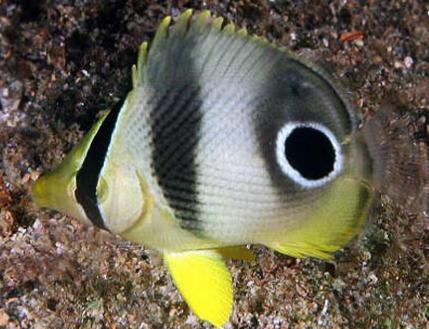



Chaetodon capistratus
| Ecological Descriptors | ||||
| Habitat | Size (cm) | Diet | Behaviour | Sex |
| Co | 15 | Wor, Tun, Gor | Pr | F |
Description:
Adult: Body thin and round in profile. Forehead slightly concave, the eye concealed by a dark bar on the head. Body silver-gray, with numerous dark, thin lines that radiate at a diagonal from the midbody/ lateral line. A black spot, ringed in white, on the rear body near the upper base of the tail. A submarginal band on the rear dorsal, tail and anal fins. Ventral fins yellow.
Juveniles: Juveniles have an extra spot on the rear of the dorsal fin that fades with age, and have 2 wide, dusky body bars.
Ecology
Inhabits shallow rocky and reef areas (2 to 20m), but with juveniles more common in seagrass beds (such as Thalassia) as shallow as 60cm. Occurs singly or in pairs. Feeds mainly on benthic invertebrates, zoantharians, polychaete worms, gorgonians and tunicates. Its characteristic short protruding snout enable the fish to easily acquire such food in between intricate crevices in coral, where small invertebrates tend to conceal themselves. They possess teeth that can be likened to fine hair-like bristles which are arranged in
narrow rows in the jaws and aid in nipping at invertebrates such as polychaete worms, tunicates, gorgonians and zoantharians in inaccessible areas.
Juveniles are normally solitary while the adults can be observed alone or in pairs. One of its more prominent features relates to its ability to manoeuvre skilfully around coral heads and reefs. They are known to swim upside down or sideways to navigate through convoluted
passages to find food and shelter. They are active during the day and sleep at night.
Life Cycle
These fish are known to pair up early in life with a mate for which they remain with for their entire life span. The courtship process involves circling one another and chasing among the reef. They are pelagic spawners, releasing their eggs and sperm into the open sea. The fish release their eggs (3000-4000 small eggs) into the water amongst the plankton. The larvae grow into the post-larval tholichthys stage with a bony armour around their head from which bony plates protrude for protection. They are silver/grey in colour and are nearly transparent. The tholichthys then assume the physical form of the juvenile stage with regards to their colour.
Adult: Body thin and round in profile. Forehead slightly concave, the eye concealed by a dark bar on the head. Body silver-gray, with numerous dark, thin lines that radiate at a diagonal from the midbody/ lateral line. A black spot, ringed in white, on the rear body near the upper base of the tail. A submarginal band on the rear dorsal, tail and anal fins. Ventral fins yellow.
Juveniles: Juveniles have an extra spot on the rear of the dorsal fin that fades with age, and have 2 wide, dusky body bars.
Ecology
Inhabits shallow rocky and reef areas (2 to 20m), but with juveniles more common in seagrass beds (such as Thalassia) as shallow as 60cm. Occurs singly or in pairs. Feeds mainly on benthic invertebrates, zoantharians, polychaete worms, gorgonians and tunicates. Its characteristic short protruding snout enable the fish to easily acquire such food in between intricate crevices in coral, where small invertebrates tend to conceal themselves. They possess teeth that can be likened to fine hair-like bristles which are arranged in
narrow rows in the jaws and aid in nipping at invertebrates such as polychaete worms, tunicates, gorgonians and zoantharians in inaccessible areas.
Juveniles are normally solitary while the adults can be observed alone or in pairs. One of its more prominent features relates to its ability to manoeuvre skilfully around coral heads and reefs. They are known to swim upside down or sideways to navigate through convoluted
passages to find food and shelter. They are active during the day and sleep at night.
Life Cycle
These fish are known to pair up early in life with a mate for which they remain with for their entire life span. The courtship process involves circling one another and chasing among the reef. They are pelagic spawners, releasing their eggs and sperm into the open sea. The fish release their eggs (3000-4000 small eggs) into the water amongst the plankton. The larvae grow into the post-larval tholichthys stage with a bony armour around their head from which bony plates protrude for protection. They are silver/grey in colour and are nearly transparent. The tholichthys then assume the physical form of the juvenile stage with regards to their colour.
Foureye Butterflyfish Adult
Foureye Butterflyfish Intermediate
Foureye Butterflyfish Juvenile
Foureye Butterflyfish Adult

(C) Kevin Bryant




176


10


324



